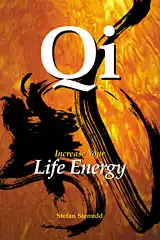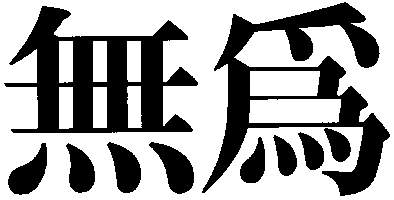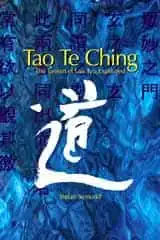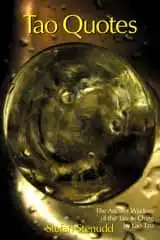|
Tao Te Ching
THE TAOISM OF LAO TZU
|
The Tao Theme of
|
The Book
The Taoism of Lao Tzu Explained. The great Taoist philosophy classic by Lao Tzu translated, and each of the 81 chapters extensively commented. Click the image to see the book at Amazon (paid link). |
2. Don't Split the Unity
When everyone in the world sees beauty,Then ugly exists.
When everyone sees good,
Then bad exists.
Therefore:
What is and what is not create each other.
Difficult and easy complement each other.
Tall and short shape each other.
High and low rest on each other.
Voice and tone blend with each other.
First and last follow each other.
So, the sage acts by doing nothing,
Teaches without speaking,
Attends all things without making claim on them,
Works for them without making them dependent,
Demands no honor for his deed.
Because he demands no honor,
He will never be dishonored.
3. As Little as Possible
Not praising the deservingPrevents envy.
Not valuing wealth
Prevents theft.
Not displaying what's desirable
Prevents confusion of the senses.
Therefore:
The sage governs by emptying senses and filling bellies,
Curbing strife and strengthening backs,
Keeping the people ignorant and without desire,
Making the learned afraid to act.
If he acts without action, order will prevail.
11. The Necessity of Emptiness
Thirty spokes are joined in the wheel's hub.The hole in the middle makes it useful.
Mold clay into a bowl.
The empty space makes it useful.
Cut out doors and windows for the house.
The holes make it useful.
Therefore, the value comes from what is there,
But the use comes from what is not there.
29. Don't Change the World
Conquering the world and changing it,I do not think it can succeed.
The world is a sacred vessel that cannot be changed.
He who changes it will destroy it.
He who seizes it will lose it.
So, among all things,
Some lead and some follow,
Some sigh and some pant,
Some are strong and some are weak,
Some overcome and some succumb.
Therefore the sage avoids extremity, excess, and extravagance.
37. Nameless Simplicity
The Way is ever without action,Yet nothing is left undone.
If princes and kings can abide by this,
All things will form themselves.
If they form themselves and desires arise,
I subdue them with nameless simplicity.
Nameless simplicity will indeed free them from desires.
Without desire there is stillness,
And the world settles by itself.
43. Non-Action
The softest in the worldSurpasses the hardest in the world.
What has no substance
Can penetrate what has no opening.
Thereby I know the value of non-action.
The value of teaching without words
And accomplishing without action
Is understood by few in the world.
47. Understanding without Exploring
Without stepping out the door,You can know the world.
Without looking through the window,
You can see Heaven's Way.
The longer you travel, the less you know.
Therefore:
The sage knows without traveling,
Perceives without looking,
Completes without acting.
48. Let Go
Those who seek knowledge,Collect something every day.
Those who seek the Way,
Let go of something every day.
They let go and let go,
Until reaching no action.
When nothing is done,
Nothing is left undone.
Never take over the world to tamper with it.
Those who want to tamper with it
Are not fit to take over the world.
63. Big Is Small at First
Act without action.Pursue without interfering.
Taste the tasteless.
Make the small big and the few many.
Return animosity with virtue.
Meet the difficult while it is easy.
Meet the big while it is small.
The most difficult in the world
Must be easy in its beginning.
The biggest in the world
Is small in its beginning.
So, the sage never strives for greatness,
And can therefore accomplish greatness.
Lightly given promises
Must meet with little trust.
Taking things lightly
Must lead to big difficulties.
So, the sage regards things as difficult,
And thereby avoids difficulty.
64. The Sage Dares Not Act
Stillness is easy to maintain.What has not yet emerged is easy to prevent.
The brittle is easy to shatter.
The small is easy to scatter.
Solve it before it happens.
Order it before chaos emerges.
A tree as wide as a man's embrace
Grows from a tiny shoot.
A tower of nine stories
Starts with a pile of dirt.
A climb of eight hundred feet
Starts where the foot stands.
Those who act will fail.
Those who seize will lose.
So, the sage does not act and therefore does not fail,
Does not seize and therefore does not lose.
People fail at the threshold of success.
Be as cautious at the end as at the beginning.
Then there will be no failure.
Therefore the sage desires no desire,
Does not value rare treasures,
Learns without learning,
Recovers what people have left behind.
He wants all things to follow their own nature,
But dares not act.
Tao Themes
Tao Themes Introduction
Tao — The Way
Te — Virtue
Sheng Jen — The Sage
Wu Wei — Non-action
Moderation
Ruling
War
My Taoism BooksClick the image to see the book at Amazon (paid link).
The Taoism of Lao Tzu Explained. The great Taoist philosophy classic by Lao Tzu translated, and each of the 81 chapters extensively commented. |
About Cookies
My Other Websites:
I Ching Online
The 64 hexagrams of the Chinese classic I Ching and what they mean in divination. Try it online for free.
Qi Energy Exercises
The ancient Chinese life energy qi (chi) explained, with simple instructions on how to exercise it.
Life Energy
The many ancient and modern life force beliefs all over the world explained and compared.
Taoismen på svenska
Other Books by Stefan Stenudd
Click the image to see the book at Amazon (paid link).
 Cosmos of the Ancients
Cosmos of the Ancients
The Greek philosophers and what they thought about cosmology, myth, and the gods.
 Qi — Increase Your Life Energy
Qi — Increase Your Life Energy
The life energy qi (also chi or ki) explained, with exercises on how to awaken, increase and use it.
 Aikido Principles
Aikido Principles
Basic concepts of the peaceful martial art. Aikido principles, philosophy, and fundamental ideas.
 Life Energy Encyclopedia
Life Energy Encyclopedia
Qi, prana, spirit, ruach, pneuma, and many other life forces around the world explained and compared.
 Archetypes of Mythology
Archetypes of Mythology
Jungian theories on myth and religion examined, from Carl G. Jung to Jordan B. Peterson.
 Stefan Stenudd
Stefan Stenudd
About me
I'm a Swedish author and aikido instructor. In addition to fiction, I've written books about Taoism and other East Asian traditions. I'm also an historian of ideas, researching ancient thought and mythology. Click the image to get to my personal website.Contact

 Tao Te Ching
Tao Te Ching Tao Quotes
Tao Quotes Fake Lao Tzu Quotes
Fake Lao Tzu Quotes